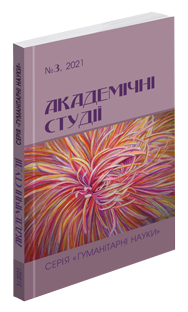Abstract
The present research substantiates the concept of cognitive consonance as a factor of cognitive equivalence of chronologically distant retranslations from the standpoint of the theory and practice of translation. The material of the research is William Shakespeare’s tragedy “King Lear” (1605), which is chronologically distant original, and its three different Ukrainian retranslations performed by P. Kulish (1880), M. Rylsky (1941) and W. Barka (1969). The article determines the phenomenon of diachronic plurality in retranslations of a chronologically distant original as a problem of translation studies. Different socio-historical contexts and literary styles in which the analyzed diachronic retranslations are performed are characterized. The article considers the consonance and dissonance correlation as categories of harmony in music theory. The research explains the cognitive consonance specifics in the theory and practice of translation and the factors that determine the degree of convergence with the original. Cognitive equivalence is understood as a result of the harmonious identity of the mental processes of the author and the translator, which is the basis of functional-communicative coincidence and pragmatic equivalence of the original text and its retranslations. The parameters of cognitive equivalence of the original units and translation units, which is established in terms of cognitive consonance, are defined in the article. The cognitive equivalence of the author’s and translators’ mental processes is realized in two forms: complete cognitive equivalence (complete identity of the form and content) and partial cognitive equivalence (form of original units and translation units is violated, but content identity is preserved).
References
Бойко Я. Образність часово віддаленого першотвору в контексті діахронної множинності перекладів (на матеріалі ретрансляцій трагедії У. Шекспіра “The Tragedy of Hamlet”). Вісник Київського національного лінгвістичного університету. Серія «Філологія». Том 23. № 2. 2020. C. 19–29.
Бойко Я. Своєрідність мови Шекспіра і мови українських ретрансляцій як знакових систем в історичній перспективі. Scientific Collection “InterConf” (63): with the Proceedings of the 2nd International Scientific and Practical Conference “International Scientific Discussion: Problems, Tasks and Prospects” (June 21–22, 2021). Brighton, Great Britain : A.C.M. Webb Publishing Co Ltd., 2021. Р. 121–138.
Лучук О. Часовий фактор і проблема перекладної множинності в теорії художнього перекладу. Діалогічна природа літератури. Перекладознавчі та літературознавчі нариси. Львів : Вид-во УКУ, 2004. С. 163–168.
Boiko Y., Nikonova V. Cognitive model of the tragic in Ukrainian retranslations of Shakespeare’s plays. Journal of Language and Linguistic Studies, 17 (Special Issue 2), 2021. Р. 1034–1052.
Sickinger P. Aming for cognitive equivalence – mental models as a tertium comparationis for translation and empirical semantics. Research in Language, 2017, vol. 15 (2). Р. 213–236.
Tashchenko G. V. Cognitive equivalence as a criterion of the precedent name Translation. Science and Education a New Dimension. Philology. V (39). Issue: 143. 2017. URL: www.seanewdim.com (дата звернення: 17.11.2021).

